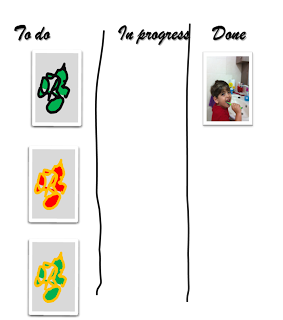A question I hear all the time is
- ‘how can we use the task board with our younger kids, who can’t read or write
yet?’
Being a parent to young kids is
exactly the same as with the older kids. The parents try to get the child to do
his tasks, stick to a routine, keep boundaries, have a good connection with
with them, all while keeping nagging down to a minimum.
The answer I give all the time is
surprisingly simple.
‘Use pictures’
All the other rules apply as
usual.
When they get a ‘wait, what?’
look on their faces, I explain a bit further.
●
Put the tasks on the board to
visualise them
●
Choose your next task
●
Gather every day to talk about the
tasks
So in fact, most of the tasks can
be shown in picture format anyway. It might even be better this way for all the
family :)
So how to go about this:
1.
Prepare the child to a fun adventure.Have
fun with the kids! I mean, you’re going to be wandering around the house
snapping pictures with them (and they’ll want to take some pictures themselves
if they are anything like my kids). What could be more fun?
2.
Snap pictures of your kids
doing their routine tasks. Brushing their teeth, waking up in the morning.
Let them snap pictures of you doing the same. Explain each task as the kid is
doing it.
3. This is an awesome opportunity to
do things together, and to set expectations.
4.
Now, ask your kids to put the
pictures up on the task board (Some velcro on the back of each one and the
board itself is probably best). Make sure to refer to each task as you place it
on the board - for example, ‘and here you are, brushing your teeth’.
Note that you can use the family task board, a personal task board in the child
room or even a personal book (if they are very small children).
5.
Be sure to keep it simple.
They are kids, after all. Don’t use too many pictures, or ones that it isn’t
clear what the child has to do.
OK, so you’ve got the pictures up
on the board. Now what?
1.
You and your kids choose a
series of pictures (tasks, remember?) to do the next day. Ask your children
what they are going to do when they wake up.
2.
Put the pictures on the board
- make sure the order is clear.
3.
In the morning, remind your
kids that the board and pictures is there, and go to the board with them.
4.
Go through the tasks as shown by
the pictures, and move the completed pictures into the ‘Done’ column.
5.
When your kids have completed all
the tasks, let them know they’ve done an excellent job - they deserve it :)
6.
Gather round the board the
next evening, and repeat.
Wasn’t that great?
Of course, what the pictures show
is entirely up to you. I prefer showing my kids actually performing the action
they are supposed to - brushing their teeth, as opposed to just showing the
toothbrush - as it is the actual task he needs to follow through.
Plus, it’s tremendous fun!
It’s the fun of snapping the
photos, it’s the fun of creating the board, it’s the fun of seeing how
things are getting done without
focusing on what isn’t done. It’s the fun of actually talking with your kids
and having a dialogue.
Remember - when your kids see
what they need to do, and know that we are there to help if needed, and talking
about it, they find it much easier. In time, these tasks will become part of
the routine, and you can move on to others!
And as I said before - using
photos and pictures works wonders with the older kids as well. After all,
visualization makes things so much easier to understand!
Want to learn more about task boards,
kids, and how to get things done around the house? Get Agile Kids today!
Further read from this blog:





